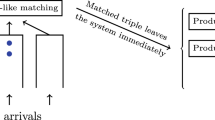Abstract
The goal of this paper is to provide a model that is an extension of classic scheduling problems for a tandem queueing system by including customer impatience. In such scenarios, the server(s) must balance abandonments from each phase of service with the need to prioritize higher reward customers. This presents an interesting challenge since the trade-off between the cost of abandonments and revenue maximization is not at all clear. As a result of customer abandonments, traditional solution techniques are not available. In particular, uniformization is not possible since the transition rates are unbounded. We do our analysis in continuous time, using the continuous-time Markov decision process framework to discern simple relationships of the value functions depending on the starting state. We then use sample path arguments to analyze the structure of the optimal policy. We provide conditions under which an optimal policy is nonidling and never splits servers (except to avoid idling). We then consider the single-server model as a proxy for the decision problem when there are more customers at each station than there are servers. In this case, we provide conditions under which it is optimal to prioritize each station.
Similar content being viewed by others
References
Ahn, H.-S., Duenyas, I., Lewis, M.E.: Optimal control of a two-stage tandem queueing system with flexible servers. Probab. Eng. Inf. Sci. 16, 453–469 (2002)
Ahn, H.-S., Duenyas, I., Zhang, R.Q.: Optimal stochastic scheduling of a two-stage tandem queue with parallel servers. Adv. Appl. Probab. 31(4), 1095–1117 (1999)
Ahn, H.-S., Righter, R.: Dynamic load balancing with flexible workers. Adv. Appl. Probab. 38(3), 621–642 (2006)
Andradóttir, S., Ayhan, H.: Throughput maximization for tandem lines with two stations and flexible servers. Oper. Res. 53(3), 516–531 (2005)
Andradóttir, S., Ayhan, H., Down, D.G.: Server assignment policies for maximizing the steady-state throughput of finite queueing systems. Manage. Sci. 47(10), 1421–1439 (2001)
Andradóttir, S., Ayhan, H., Down, D.G.: Dynamic server allocation for queueing networks with flexible servers. Oper. Res. 51(6), 952–968 (2003)
Buyukkoc, C., Varaiya, P., Walrand, J.: The \(c\mu \)-rule revisited. Adv. Appl. Probab. 17(1), 237–238 (1985)
Dobson, G., Tezcan, T., Tilson, V.: Optimal workflow decisions for investigators in systems with interruptions. Manage. Sci. 59(5), 1125–1141 (2013)
Duenyas, I., Gupta, D., Olsen, T.L.: Control of a single-server tandem queueing system with setups. Oper. Res. 46(2), 218–230 (1998)
Huang, J., Carmeli, B., Mandelbaum, A.: Control of patient flow in emergency departments, or multiclass queues with deadlines and feedback. Oper. Res. 63(4), 892–908 (2015)
Iravani, S., Posner, M.J.M., Buzacott, J.A.: A two-stage tandem queue attended by a moving server with holding and switching costs. Queueing Syst. 26(3–4), 203–228 (1997)
Johri, P., Katehakis, M.N.: Scheduling service in tandem queues attended by a single-server. Stoch. Anal. Appl. 6(3), 279–288 (1988)
Kaufman, D.L., Ahn, H.-S., Lewis, M.E.: On the introduction of an agile, temporary workforce into a tandem queueing system. Queueing Syst. 51(1–2), 135–171 (2005)
Lippman, S.: Applying a new device in the optimization of exponential queuing systems. Oper. Res. 23(4), 687–710 (1975)
Nelson, R.: Labor assignment as a dynamic control problem. Oper. Res. 14(3), 369–376 (1966)
Saghafian, S., Hopp, W.J., Van Oyen, M.P., Desmond, J.S., Kronick, S.L.: Complexity-augmented triage: a tool for improving patient safety and operational efficiency. Manuf. Serv. Oper. Manag. 16(3), 329–345 (2014)
Van Oyen, M., Teneketzis, D.: Optimal stochastic scheduling of forest networks with switching penalties. Adv. Appl. Probab. 26(2), 474–497 (1994)
Van Oyen, M.P., Gel, E.G., Hopp, W.J.: Performance opportunity for workforce agility in collaborative and noncollaborative work systems. IIE Trans. 33(9), 761–777 (2001)
Author information
Authors and Affiliations
Corresponding author
Electronic supplementary material
Below is the link to the electronic supplementary material.
Rights and permissions
About this article
Cite this article
Zayas-Cabán, G., Xie, J., Green, L.V. et al. Dynamic control of a tandem system with abandonments. Queueing Syst 84, 279–293 (2016). https://doi.org/10.1007/s11134-016-9489-7
Received:
Revised:
Published:
Issue Date:
DOI: https://doi.org/10.1007/s11134-016-9489-7




